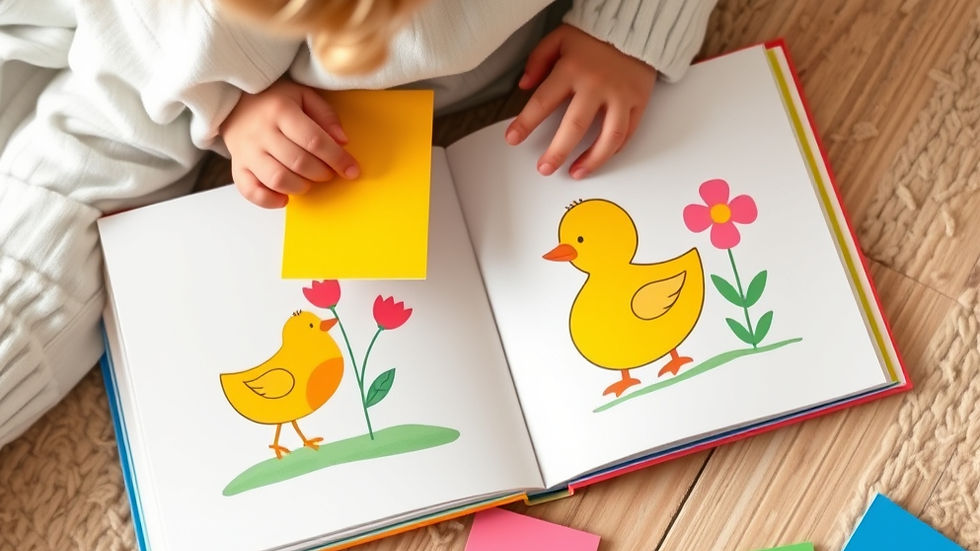How to Use Color Flashcards: 10 Fun & Engaging Low-Prep Activities
- funprek
%20white%20bcg.jpg/v1/fill/w_320,h_320/file.jpg)
- Jul 13
- 6 min read
Updated: Aug 11
Colors are often the first step in a child’s learning journey, and Color Flashcards are great for focused and quick progress – just a few minutes a day will be sufficient.
Start with just a few basic colors – red, yellow, and green, for example – either one by one or all together. As the child becomes more confident, gradually add more.

Engaging with Colors: A Fun Journey
All right, you DIY crafted or purchased your Color Flashcards, printed and laminated them. What’s next? Here are our 10 favorites – not just for learning colors, but also for building a whole range of age-appropriate skills:
10. It's Unreal!
1. Bookish Colors with Color Flashcards
Ah, these colorful baby books our littles love! They are full of pictures, colors, and stories. Pick one color flashcard and search for this color in the book. It helps a toddler if you slowly move the card along the page to spot the color. If the child can’t speak yet, they might point to the pictures or parts of the illustration.
Next level: hold the card or place it next to the book while flipping the pages and pointing to the elements with our target color.
And a step further – just open a book and ask the child to choose color flashcards matching the colors they see on the page.

With this activity, kids learn to identify colors while building vocabulary and developing attention to detail.
2. What’s Your Color?
It’s a classic Montessori matching activity. Here, the child matches objects to color flashcards. These can be educational toys (like counting bears or color blocks) or anything you find around the house: buttons, bottle caps, flowers, LEGO blocks, stickers, cardboard circles painted with markers – really, just anything.
Prepare your manipulatives (objects of different colors) in a basket. Then suggest one or a few color flashcards. Invite the child to pick one object at a time, name the color, and place it on the corresponding card. Continue until all the objects are sorted.
3. Memory Teaser: Toddler Flashcard Game
Place 3 color flashcards on the table and let the child memorize these colors. You can even talk about the colors, discuss related objects, or give little “hints.” Then ask the child to close their eyes. Hide one of the cards. Which one is missing?
Is your kid too young or having trouble saying the word? Show them the color chart (downloadable for free here) and suggest they point to the missing color. Want more fun? Let a teddy bear do the job!

4. Colors for Coloring
Choose a coloring page. Pick a few random color cards – and let the magic begin! Ask the child to describe the subject on the page and how they plan to distribute colors (and why).
You might give out one color at a time, and once it’s used, it can’t be used again. Or offer all the color cards together and let the child use their imagination in the complete set-up. There’s no limit to creativity – the more unique the creation, the more it reflects imagination and creative freedom – and the better your child feels about themselves.
5. I See Something Yellow
This classic game is a fun way to practice color recognition and observation skills.
For little kids, simply say, “I see something yellow,” and encourage them to find yellow items around the room. They can point to or bring the objects to you. For older kids or groups, make it a friendly competition: have them look around, write down the yellow items they spot, and then compare who found the most. You can also set a challenge – like writing down 10 yellow objects as fast as possible, ringing a bell to be the winner, or seeing who can write the most within one minute.
This game sharpens color recognition, attention to detail, and quick thinking — all while keeping things fun and social!

6. Let’s Color the Day
Choose a color and make it the theme for the day – wear clothes, use objects, and even eat food in that color!
Plan the day together the night before using a matching color pencil to draft your outfit ideas, activities, or snacks. Check the weather too, and think about how it might influence your choices—like bright yellow on a sunny day or cozy blue when it’s chilly.
In class, turn it into a “color party” with themed toys, colorful treats, and games. At home, try simple crafts, drawing, or reading stories about the color of the day. This fun routine builds color recognition, planning skills, creativity, and teamwork—all wrapped in a joyful experience.
7. Color Clean-Up
Does your child resist cleaning up their toys at the end of the day? Grab your set of color flashcards and turn it into a game! Start by choosing one color and have your child collect all the toys in that color. Then move on to the next.
To win over any excuses, try a simple trick – set a timer and challenge your child to pick up all the toys of a color before the timer goes off. It can also become a fun and cozy pre-bedtime routine for the whole family: siblings and even parents can each pick a color and tidy up together.
If you're working with several kids (or a classroom group), each child can be in charge of a specific color. Parents or teachers can help by dividing the colors and guiding the group. Suddenly, clean-up becomes playful, purposeful, and even something to look forward to.

8. Creative Drawing with Color Flashcards
Think of a picture you'd like to draw. What colors will you need? For example, if you're drawing an apple tree with a bird, you might choose green, red, brown, and blue.
Take those color flashcards, mix them up, and place them in a random order. Now, draw your picture following the order of the cards! You might start with red apples, then add the bird, and draw the tree trunk last. The picture won't always come together in the "usual" way – but that’s the point!
Want to add a twist? Children (or a child and an adult) – either in or outside school settings – can each use the same set of colors, but in different shuffled orders. Then compare the results. Same idea, completely different pictures!
This activity helps kids learn to plan their ideas, think ahead about space on the page, and stretch their creativity by breaking out of familiar patterns.

9. Developing Communication Skills
Take a set of color flashcards, shuffle them, and choose one at random. Now the challenge begins! Look around and find someone wearing that color. Go up, say hello, or start a simple conversation. You can ask a question, give a compliment, or greet them with a smile.
This works especially well in a group or class setting – kids can each pick a card and take turns approaching others. It’s a fun way to gently practice communication, build confidence, and become more aware of colors in real-life situations.
This activity can also be paired with other subjects:
Acting: Turn it into a role-play game – greet someone as a character or invent a silly color-based dialogue.
Art: After the conversation, draw a scene that includes the person and their colorful outfit.
Writing: Older kids can write a few sentences or a short story using the color as inspiration.
Language development: Practice polite phrases, conversation starters, or descriptions of the color (bright red, soft pink, etc.).
It’s a playful way to blend color recognition with social skills, creativity, and expressive language—all through one simple activity.

Extra tip: Speaking to a stranger can feel intimidating at first. If that’s the case, start the game with people your child knows well — siblings, grandparents, classmates, or a friendly neighbor. This gentle start helps build up confidence, and with each try, it gets easier and more fun to speak to someone new.
10. It’s Unreal!
Choose a color flashcard. Now think—what cannot be that color? The funnier, the better! Try to come up with five things that would look totally silly in that color. Like a green flying cow, a purple spaghetti, or a blue sandwich!
Kids can either draw these wild ideas or make a list. In a group setting, take turns sharing and see who gets the biggest laugh! This activity is especially fun in classrooms, but it works just as well at home.
It’s a great way to mix creativity, critical thinking, and humor—while still reinforcing color awareness and vocabulary.
_____________
Colors are all around us — in books, toys, clothes, and even in our conversations. With just a little creativity, your flashcards can open the door to playful learning moments that feel more like fun than work. Whether you're at home, in a classroom, or out and about, these small cards can spark big smiles, curious minds, and quality time together.
Let’s have fun!
Want more? Don’t forget to check out our free printables, creative add-ons, and the Color Flashcards set in the shop — all designed to support joyful, hands-on learning every day.















Comments